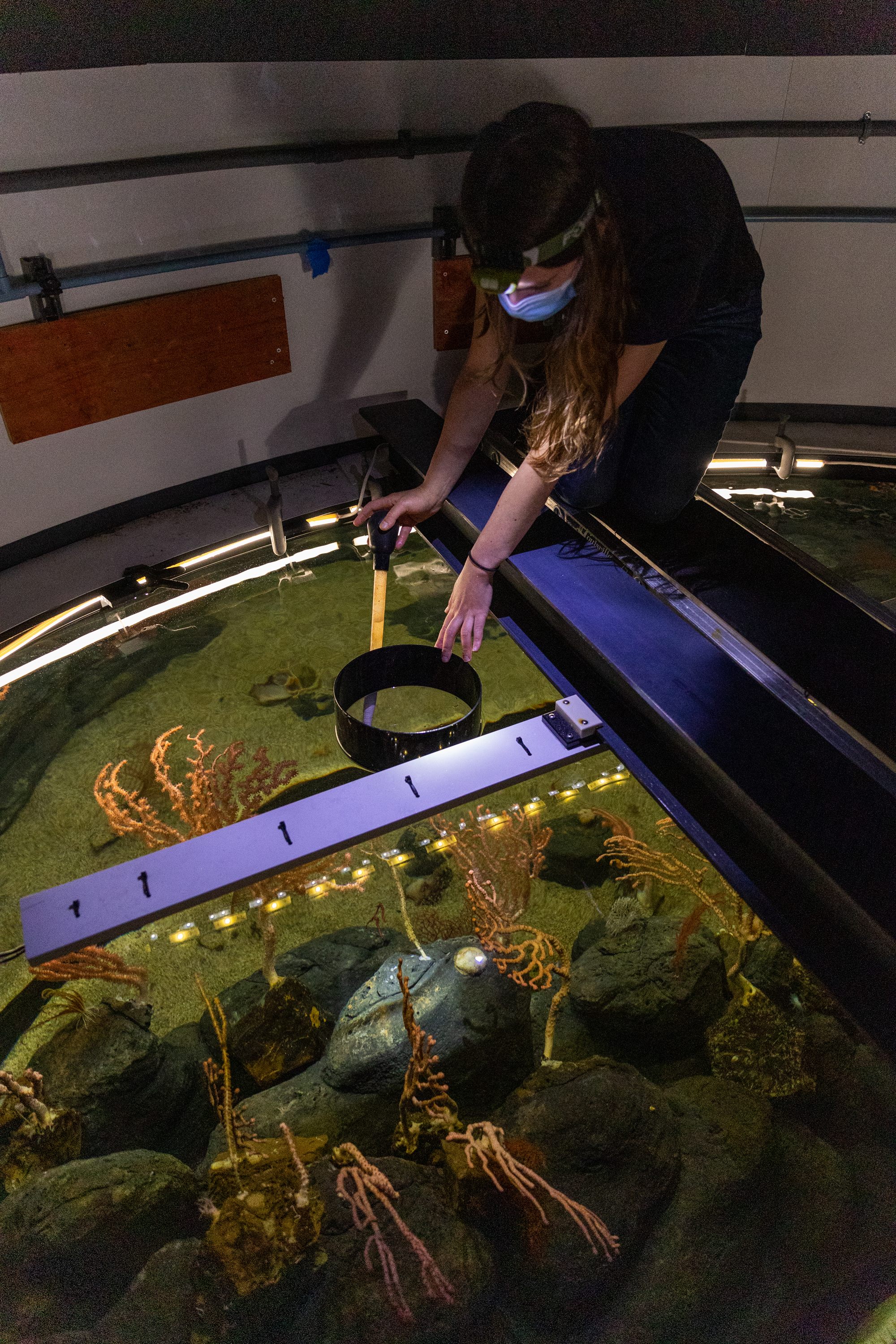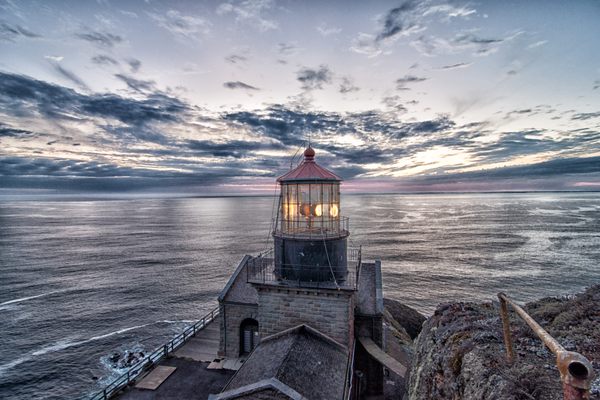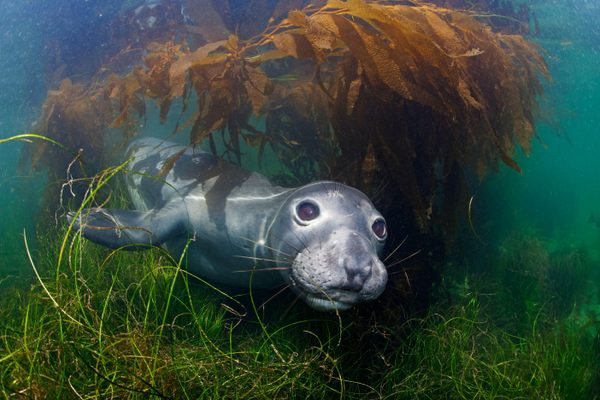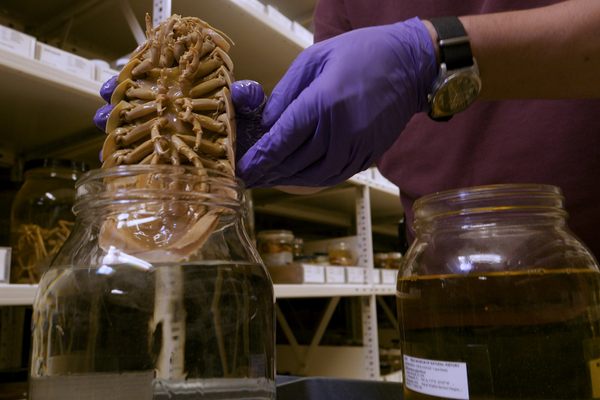
How to Recreate the Deepest, Darkest Ocean
Revealing the unseen world under Monterey Bay.
Tommy Knowles peers into an illuminated column of seawater and gestures at what looks like the dangliest of dangly earrings, except it’s made of clear, gelatinous goo. When this improbable accumulation starts propelling itself through the water in graceful loops, he beams. “This is one of my favorites,” says the senior aquarist at the Monterey Bay Aquarium in California. “Something I really wanted to be able to pull off was exhibiting a siphonophore.”
These predatory marine invertebrates—actually a colony of specialized creatures that form a single organism—spend their days at depths of 1,000 feet or more, but migrate up to the surface every night to feed on krill and the billions of other marine critters that make the same trek. The daily cycle, known as diel vertical migration, is the largest animal migration on the planet.

Up close, you can count four sets of several translucent, head-like bells, each pulling a shimmering, segmented tail, at once pendulous and filamentous. The curvature of the cylindrical tank magnifies and multiplies the pulsing chains, lit from above and below. Unlike some of their giant relatives—which can grow up to 150 feet in length, and include the Portuguese man-o-war—these common siphonophores (Nanomia bijuga) are just a modest 12 inches, but they are unique: the only siphonophores on display anywhere in the world. It took five years and many breakthroughs for the aquarium to recreate the subtle strangeness of the deep, open sea in tanks for its newest permanent exhibit, Into the Deep. The installation showcases dozens of different species across more than 20 habitats, most of which inhabit the depths of Monterey Bay, creatures that are not really that far away but seem entirely alien, rarely thought of and even more rarely seen. But actually, says Knowles, they’re not rare at all.
“They’re really numerous residents of Monterey Bay,” he says. “They’re just really underappreciated because they’re hard to see.”

And they’re hard to see because of our perspective: on the surface, lungs full of oxygen-rich air, surrounded by a single atmosphere of air pressure, with the sun for both light and warmth. The enclosure containing the siphonophores has none of these things, and the creatures seem to be at home.
Going Deep
Oceanographically speaking, the surface waters of the ocean extend as far down as there is sunlight for photosynthesis, up to about 650 feet. That is the ocean we know best—whale pods gliding just beneath the surface, swirling shoals of anchovies, teeming, vibrant tropical reefs, the kelp forests full of otters that sit just outside the aquarium. Very few humans have ever ventured beyond this zone.

An imaginary submarine traveling out into Monterey Bay—450 square miles that look like a bite taken out of the central California coast—would pass through the surface waters to midwater, where light begins to fade, temperature and oxygen decline, and pressure steadily increases. The midwater, from 650 feet to the ocean floor, between three and seven miles below, is simultaneously the largest habitat on Earth and the least known to science.
Just north of the aquarium, in the middle of the bay, is the beginning of Monterey Canyon, a deep gouge in the seafloor that snakes 250 miles out to sea. It formed over millions of years by underwater avalanches of sand and sediment known as turbidity currents. One of the deepest underwater canyons in the world, with walls more than a mile high, it ends two and a half miles below the surface.
The midwater has several zones: from the mesopelagic “twilight zone” (650 feet to 0.62 miles), where some residual light lingers, to the bathypelagic “midnight zone” (0.62 to 2.5 miles), where light is a fiction. With no ambient light, many animals create their own bioluminescence to attract prey, confuse predators, communicate, or find a mate. There, deep sea corals and predatory tunicates cling to rocky canyon walls, barreleye fishes with translucent heads hunt for bioluminescent prey, and bone-eating worms make quick work of the remains of larger creatures that sink to the depths.
Beyond Monterey Canyon lie the further depths of the Pacific Ocean: the abyssal plains (2.5 to 3.7 miles) and the hadal trenches (3.7 to 7 miles). Despite names such as “abyssal” and “hadal,” these are not lifeless underworlds, but rather are home to vibrant displays of biodiversity, in ecosystems such as underwater mountain chains, deep sea coral reefs, and fallen whale carcassess.
The aquarium has long been dedicated to reflecting the body of water on which it sits, from shorebirds to intertidal zones to massive, undulating schools of Pacific sardines. But the deeper parts of its home bay—while a subject of ongoing study at the aquarium’s research partner, Monterey Bay Aquarium Research Institute (MBARI)—wouldn’t be easy to show to the general public.
When the aquarium committed to a deep sea exhibit, Knowles and the rest of the team were tasked with a number of challenges, difficult even for experienced aquarists. How do you build a tank for animals that live without ever encountering a hard surface—some of which can disintegrate upon contact? How do you maintain the extreme physical and chemical properties that deep sea organisms need? What environmental cues do these species rely on to know when to eat or reproduce?
Some of these questions were answered over the course of the five-year development period for the exhibit, in time for opening day. Others remain mysteries.
Making an Alien World
Recreating a deep sea environment is an exercise in marine chemistry, fluid dynamics, and lateral thinking. Aquarists have a suite of tools and technologies at their disposal to make hospitable habitats for an endless parade of marine species, but in general many of these methods have proven inadequate to the conditions of the deep sea. So at Monterey Bay they turned to a combination of novel tech and clever workarounds. Behind the scenes, a wall of interconnected tubes, pipes, and dials carefully control water temperature, pH, and particularly oxygen to match the conditions for which these organisms evolved.
Knowles says that everyone always asks him about the extreme pressure of the deep sea, in particular. Pressurizing tanks would require an expensive and potentially dangerous feat of engineering. (Imagine a viewing window flying off a tank with 200 times the pressure of a sparking wine cork behind it.) Fortunately all of the animals they’ve cultivated, so far at least, have done just fine when they’re brought up to or raised at surface pressure.
Of the three environmental levers that require constant adjustment, temperature and pH are the most straightforward to handle. The aquarium has plenty of experience cooling water for its exhibits. The low pH that is characteristic of the deep sea is similarly simple to achieve and maintain (for a world-class aquarium, that is). The exceedingly low oxygen, however, that’s tough.

In the open ocean, oxygen mixes into seawater at the surface, but its concentration tends to decrease with depth. Many of the animals on display are adapted to live at or near the oxygen minimum zone, where dissolved oxygen is just 5 percent of surface water levels. By comparison, the top of Mount Everest has approximately 33 percent of the oxygen available at sea level, which is enough to incapacitate or kill an unprepared person. The vertical migrators, such as the siphonophore, might be able to tolerate more oxygen-rich waters for short periods of time, but they won’t thrive unless the concentration of the dissolved gas is kept precariously low. For others, too much oxygen can be toxic or deadly.
The enclosures in the exhibit must therefore be sealed so their water does not contact the surrounding air. The traditional approach to further lowering oxygen in an aquarium is to bubble nitrogen through it, which displaces the oxygen dissolved in the water. This only works up to a point, however, as eventually the water becomes saturated, causing the nitrogen to start bubbling out of the solution, which essentially gives any organisms living inside the bends, or decompression sickness—the nitrogen starts to bubble out within their bodies as well, with predictably terrible results.
The aquarium had to figure how to pull excess gas out, so they turned to a degassing technique used in food processing. Water passes through a semipermeable membrane—essentially a filter so fine that it can strip gasses out of solution—to create the miniscule oxygen levels that the animals require. To Knowles’s knowledge, they are the only aquarium in the world using this technique.

Controlling the flow of water is another challenge. In the open ocean there are no physical structures or barriers, so gelatinous deep sea species are rarely in danger of running into anything, even when currents push them around. They’re not built to run into the side of a sealed tank; some will just dissolve on contact. But still the water must be cycled and filtered—without creating a current too strong for the delicate animals.
A couple of innovative tank designs were used to achieve nearly motionless water that is still regularly exchanged. One creates a blanket of flowing water over the filter grate, which gently pushes any wandering, gelatinous creature away. The other is a sealed double cylinder like the one housing the siphonophore. In this enclosure, water flows between the two tubes and gently diffuses through a mesh grate below the inner tube. This first-of-its-kind double cylinder design is so unique and effective that Knowles and his colleagues published its design in PeerJ, an open-access academic journal, to make it available to other aquarists and researchers around the world.
Creating the perfect conditions to keep these delicate animals alive was only one—albeit significant—hurdle in making it possible to display red paper lantern jellies (Pandea rubra), siphonophores, and sea angels (Clione sp.), in addition to bottom-dwelling creatures, such as deep sea corals. The aquarists also have to get them to thrive, in some cases generation after generation.

Closing the Life Cycle
Stocking a deep sea exhibit starts where you might expect—in the deep sea. Remotely operated vehicles, such as the van-sized submarines operated by MBARI, have revealed the world of the midwater and sea floor, and their sophisticated live collection techniques have allowed them to safely transport delicate animals up to the surface.
Collecting animals from the wild is viable to an extent—after all, many are not particularly rare—and it is still the only option for some species, such as the bloody-belly comb jelly (Lampocteis cruentiventer) and the yet-to-be-named “red-x” comb jelly. And while they have had great success getting these species to thrive in captivity, they are naturally short-lived, so keeping them on display means continuous collecting. Other species, such as Stellamedusa ventana, a jelly named after MBARI’s own Ventana submarine, are rarely encountered on collection dives. Knowles himself has only collected them on two occasions, five years apart, so relying on collecting them to supply an exhibit just isn’t feasible.
The Monterey aquarists have had to figure out how to get little-known species to survive, thrive, and even reproduce in captivity. Wild-caught animals usually arrive in their final, mature stage—a pulsing comb jelly in its final medusa stage is easier to spot than a swimming, translucent larva the size of a grain of sand. This makes their care and feeding a bit simpler—husbandry needs can vary wildly when you raise animals through all their life stages—but it offers only a snapshot of the complex life cycles of many creatures.
Self-sustaining populations, on the other hand, open up doors for visitors and researchers alike to witness the progression of life, and keep exhibits full. The aquarists call this process “closing the life cycle,” and it’s exponentially harder than keeping an adult sea gooseberry (Hormiphora spp.) or mauve stinger (Pelagia flaveola) alive.
“No one’s ever seen some of these animals grow up,” Knowles says. Some species can look drastically different, inhabit totally different parts of the ocean, and eat distinct diets in their juvenile versus adult forms. In some cases, scientists might not have even realized they’re the same species at first.
Closing the life cycle isn’t a particularly straightforward process, especially for so many different species, which may have entirely different diets, behaviors, and appearances as they move through their life stages. Freshly hatched comb jellies, for example, are only 100 microns wide (roughly the width of a human hair), and thus require live food that is small enough for them to eat. In order to keep a fresh supply, the aquarium has had to essentially raise a whole food chain, starting with red and brown algae grown in massive cylindrical tanks, which is then pumped into tanks filled with tiny crustaceans called copepods.

Adult copepods are too large for baby comb jellies, but their freshly hatched young, called nauplii, are the perfect size. The husbandry staff of the aquarium filters the nauplii out through a fine sieve, to feed them to the only marginally larger comb jelly babies.
Getting to know all the stages of its animals and the needs of each requires years of trial and error, but fortunately the aquarium wasn’t starting from square one. Knowles alone has nearly two decades of experience raising and caring for jellies of various sorts. The aquarium is widely regarded as a leading institution in exhibiting jellyfish and other marine invertebrates. “I’ve had a lot of good jelly mentors,” he says. “And a lot of jelly husbandry started right in this room and other parts of this aquarium.”
One of the challenges he still faces, however, is getting some less-well-understood species—the bloody-belly and “red-x” comb jellies, for example—to spawn in captivity. He has been culturing species from surface waters for years, and he knows he can trigger a mass spawning by leaving mature adults in the dark 16 hours, then turning the lights back on, somewhat mimicking natural light exposure. Within an hour of light following a dark period, their enclosures are filled with fertilized eggs. For species in the deep sea accustomed to complete darkness, however, the light trigger, predictably, hasn’t been effective.
“I really want to crack the code,” Knowles says, “that alone is great motivation.” He plans to test other variables, such as dietary changes, which have led to more successful spawning for some species in the past.
Getting to the Bottom
While rearing and raising animals new to the public eye is an achievement in itself, the goals and potential impacts of this work go beyond public education.
The mass culturing techniques that Knowles has spent his career developing have given researchers across disciplines access to species that can help them answer fundamental questions. The warty comb jelly (Mnemiopsis leidyi), also known as the sea walnut, one of his early culturing successes, has been at the center of a decade-long debate about our earliest animal ancestors, as well as biomedical discussions about tissue regeneration.
There is an urgency to exploring the deep sea, to collecting baseline biodiversity data, to learning fast enough to understand how to protect it properly, before we change these ecosystems irrevocably. Human activities such as deepwater trawling, mining, and pollution are intensifying, and have already caused severe damage to deep seafloor environments.
The aquarium has reflected these bottom-dwelling ecosystems as well, in the form of four-foot-wide Japanese spider crabs (Macrocheira kaempferi) combing over a simulated whalefall carcass, smooth-skinned salmon snailfish (Careproctus rastrinus) that look like wriggling chicken cutlets, and a garden of branching, waving deep sea corals.

“No one realizes that there are deep sea corals,” says Michelle Kaiser, who was until recently a coral specialist on the Benthic Team. “They’re really important ecosystems and in the deep there are huge reefs of these,” she adds, gesturing toward a tank filled with branching structures covered in a fuzz of coral polyps.
These soft-bodied corals are able to survive without sunlight (unlike their tropical relatives) by capturing microorganisms from the water, so aquarists harvest a mix of rotifers and other plankton in the bay, and move the corals in the tanks around to make sure they all have equal access to food. Initially Kaiser had to do this with part or all of her body submerged in near-freezing water, until exhibit designers made a custom coral peg system with a mechanical claw.
The polyp fuzz indicates that the corals are healthy and actively grabbing food from the water column, but getting them to this point has been a long process—and one that shows the challenges of protecting or restoring deep sea ecosystems. “They’re different from tropical corals where you can tell pretty much immediately when they’re not happy,” says Kaiser, who is now an air monitoring specialist with the Monterey Bay Air Resources District. Despite a youthful palette of bubblegum and bamboo pink, many of these deep sea corals have been growing slowly for centuries. Because of that slow growth, it wasn’t possible to establish this deep-sea coral garden from fragments, a technique commonly used in tropical reef restoration projects. (For the exhibit, Kaiser had to get the MBARI team to bring up entire coral structures along with the rocks they were attached to.) Any deep sea coral restoration project would require a totally novel strategy.
This realization, a product of the aquarium’s work, shows that scientists need to know more about how these deep sea communities evolve to be able to undo or prevent more damage. The more we learn about what’s going on down there, and the more we protect intact deep reefs, the better.
It is hard enough to protect the parts of the ocean that everyone knows—tropical reefs around the world are reeling from warming seas, ocean acidification, and pollution. It’s even harder for an ecosystem that is out of sight, strange and unusual, and full of creatures that almost don’t compute as living things at all, in a place that seems openly hostile to life itself. But so often these things are a matter of understanding, and it can be hard to understand what we can’t see. Bringing these darkest places up into the light not only offers wonder and awe, but also a sense of familiarity, appreciation, and urgency.


























Follow us on Twitter to get the latest on the world's hidden wonders.
Like us on Facebook to get the latest on the world's hidden wonders.
Follow us on Twitter Like us on Facebook